Art and Craft at Windward
A Community of Artisans, Healers and Craftspeople

One place we go to find inspiration
Living with the land is a constant creative endeavor, from how we build our homes or shape the land, to how we design renewable energy systems or plant gardens. Creativity, coupled with common sense, is part of the lifeblood of land-based community living.
In addition to the general role creativity plays in our life, we cannot emphasize enough the importance of art and craft in developing a sustainable culture.
One way to think about the role of art and craft at Windward is that art is what you can create with the materials grown or harvested from the land. Craft and craftsmanship is the creative process and skill required to transform something, like a stack of lumber cut on our sawmill, into a pair of custom cabinets. Those custom cabinets may well be a work of art.
In order for art and craft to be woven into a rural village, both the raw materials and the industrial resources need to be available. In this example with the cabinets, Windward’s sustainable forestry can be understood as the embodied knowledge, practice, and skill of growing, caring for, and harvesting appropriately from the forest. The village-scale industrial resources, such as the sawmill and an assortment of woodworking tools, allow us to convert a log into lumber and then the lumber into a pair of cabinents.
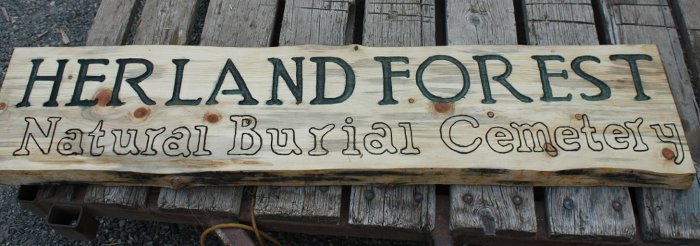
A sign carved by Andrew on wood from Windward’s forest for our natural burial project, Herland Forest
Another example that illustrates the role of craft in the bigger picture is that of animal husbandry. People who work with the sheep, for example, need the skills to care for the animals, create and manage pasture for the sheep to eat, and shear the sheep come summer. The fleeces created in the shearing process then need to be skirted and washed in large quantities. Once washed, an artisan can go to work spinning and weaving the yarn or making felt.
One of the coolest things about living in such an integrated way is that a single person can be engaged in all parts of the process. You can be the animal care-taker, engineer the systems to process the raw materials, build these systems onsite, and then go on to hone a craft that creates a useful and valuable product from the materials you stewarded into existence. Way cool!
Community-craft as Soul Craft
“Creativity is a vital expression of the soul.”
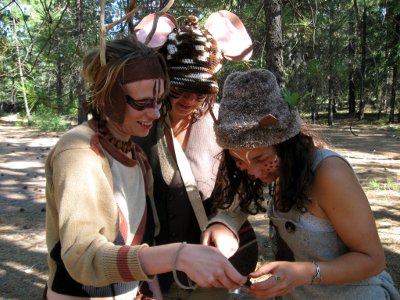
Interns putting on a forest-inspired play, 2008
While a lot of what we do here is about providing for our corporeal existence, it is equally important for us to support and encourage creative expression. Creating community is, by definition, a creative act and a work of art.

Steve playing the guitar on a 2010 autumn afternoon
No community exists in a vacuum. We are constantly compelled by nature and the wider context that we exist in to evolve and continue to create. This is true as much on the individual level as it is for the community as a whole.
It is obvious to us that everyone has a “spiritual life” that lives under the surface. A non-sectarian definition of “spiritual health” could be feeling creative, powerful and innovative, and engaging fully in life—to be connected to “the divine” in whatever form people understand that to be.
Our individual level of creative expression, or life passion, is an indicator of our mental and spiritual well being, and the soul-craft of staying connected to the inner creative drive is vital to the thriving and surviving of any community. For, when someone is disconnected from this work of the soul, they are often disconnected from other people.
When the beauty and pain and growth of life does not find an outlet, then that built up tension can express itself in unhealthy or destructive ways.
Living in community is fertile ground for personal and interpersonal exploration and evolution. By living in this intimate of a setting, we are in fact at the frontier of human society, where scarcely anyone has ever been before, exploring what is posible. In this way, perhaps one of the finest pieces of art any of us have to offer is the artwork inherent in the everday acts of our life and the expressions of our souls.
Without ways to bring people together and share our experiences, what kind of culture are we left with?
Crafts at Windward
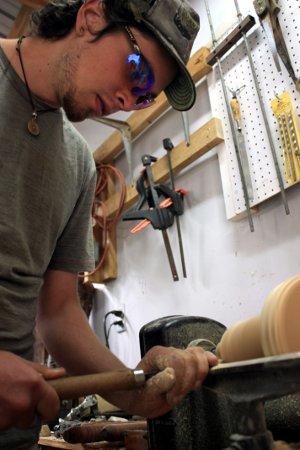
Justin, spring intern 2012, working on the lathe
Here is a general, but by no means comprehensive, list of the more practical crafts that we think are important for building a self-reliant rural village on this particular piece of marginal land. Some of these crafts are well integrated into life at Windward. Others are not yet. With all, there is room for continued growth and development.
Woodworking
For most of human history, wood was one of the most versitile natural materials people had to work with. Everything from ships to spoons were made from it. It was the plastic of it’s day. Yet, the art of working with it’s unique character, transforming board and branch into the stuff of life, took a lifetime to master.
There a many oportunities for people to work with wood in many different ways at Windward. Some of the areas of wood craft that our workshops are equiped to support include cabinetry and custom furniture making, “rustic” construction and furniture, carving, lathe work, handle-making, and underwood crafts like wattling. The possibilities are nearly endless!
Find articles about woodworking at Windward.
Metal Smithing
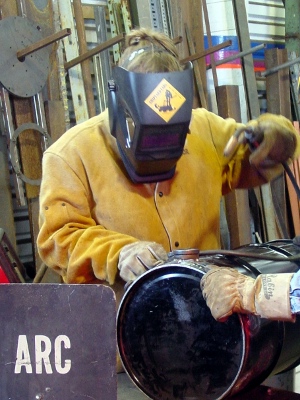
Opalyn, a Windward Steward, welding parts of her Gassifier Experimenter’s Kit
During Windward’s early years, the community operated a foundry in the Las Vegas Desert. In that time, they accumulated a lot of equipment from a variety of eras. From middle-age technology all the way up to modern induction furnace technology.
These systems are not currently set up or operating at Windward today, and we are not forging metal. It is an investment in infrastructure we have yet to make.
However, we do have a metal working shop equipped with a variety of metal fabrication equipment that we regularly employ to create and craft the tools we need.
Botanical and Healing Arts

The ancient knowledge of how to prepare herbal remedies is an art which is practically lost to most people today. For millenia, humans relied upon the natural world to provide them with the medicines that they needed to treat illness and remain in good health.
The role of plant and fungal medicines to meet the health needs of a rural community cannot be stressed enough.
To this end, some Windward members are increasing their understanding of the herbal arts, bringing home native plants that have been historically used for healing. In the process we have learned much, and strive to build a healthy working relationship with the land and it’s plant partners.
Our forest is literally overflowing with medicinals: bearberry, oregon grape, St Johnswort, hawthorn, turkey tails, and much more.
To suppliment the native species, we also grow medicinal and culinary herbs. In many ways, all the food plants we grow are medicinals, as having a well rounded diet is the best defense against infection and ill health.
While this work is not well documented on the website, there is much to do and learn in this ancient and practical craft. We hope that every person at Windward can garner a basic understanding of these medicines to be able to provide for there basic needs.
Paints, Dyes and inks
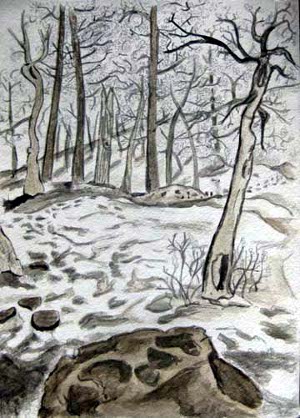
A winter landscape by Andrew using acorn and walnut ink
Working with natural pigments to enable documentation and creative expression, used to be much more important than it is today. For a long time, writing technology did not change. The U.S. Declaration of Independence was written with the same kind of iron-gall ink that was used to write on papyrus in ancient Egypt.
Not only is it fun to paint and draw, it can also be cathartic and healing, as well as practical and profitable if done well.
Beyond painting there is also the dying fibers, leather and wood for various purposes, all of which can be achieved using materials found on-site. A future full of color is possible, if we only learn the secrets in the plants and materials nature provides.
Find articles about paint, dyes, and ink.
Fiber Arts
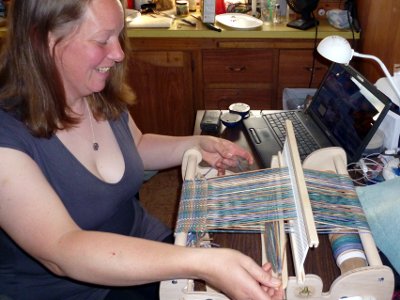
Opalyn working with a rigid-heddle loom
From skirting to cleaning, picking to carding, spinning to plying, knitting to weaving, the intricate dance from a sheep’s fleece to clothing is an age-old craft.
There is so much to do and learn in this arena and we have only begun to scratch the surface! While we recognize the importance of fibers like wool and flax to meet our need for clothing, few of us can grapple with the shear enormity of the task of actually creating clothing for ourselves.
For thousands of years, fiber arts was one of the industries that occupied a woman’s time. Before the advent of the spinning wheel (perhaps as early as 500AD in India, but not until around the 13th century in Europe) all the cloth that people wore was hand-spun!
Culturally, this translated into women (from a very young age) spending every unoccupied moment with a drop spindle, just to provide their family with one set of clothing for the year.
Flax is another material that was commonly used to create clothing in temperate regions. In modern culture, we are far more familiar with the cloth known as linen, then the plant itself or the process that transforms the raw materials into clothing. Experimental plots have shown that flax grows well at Windward, and its seed is also a valued oil crop. However, we have yet to delve into the processing of the plant fiber.
With both wool and flax, we are only working with these materials at a small scale right now. However, in order to provide for ourselves from this land, these crafts and industries would require much more energy and time. What makes the most sense to us, is to be able to mechanize the process as much as possible, to spare all of us the drudgery. But that is looking rather far into the future.
Find Articles about wool and flax.
Leather Making and Smithing
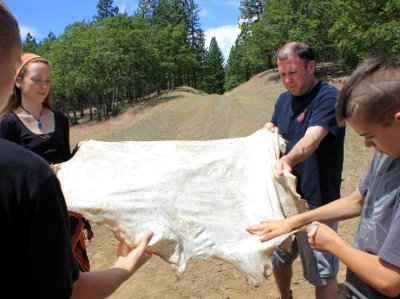
Participants in the natural tanning workshop at The Village Helix, our annual open house event
In a world without plastics and polymers, leather was one of the only natural materials capable of standing up to repeated bending and stress. From clothing to shelter to tools, tanned animal skins play an important role in creating a post-consumer village.
Currently we are working to increase our knowledge and capacity to process the raw animal skins into leathers with different qualities, suitable for different purposes. Buckskin for clothing, rawhide for cases and molds, bark tan for more sturdy outdoor applications, etc.
The actual tanning process is currently being done at a relatively small scale. In a year we may process half a dozen goat and sheep hides and two dozen rabbit pelts. In the future, preserving the leather of greater numbers of animals will require a scale more appropriately understood as a village industry in and of itself.
There is then, of course, taking the leather and making things our of it. Something which is an art and craft all of its own.
Find articles about leather working at Windward
Basketry
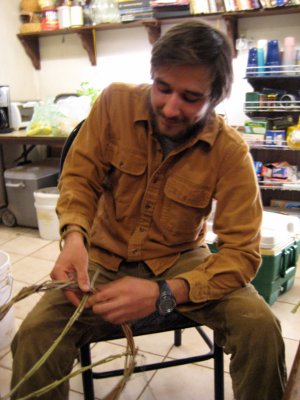
Andrew teaching how to make a willow basket
One of the things many people don’t realize about living in the modern world is the ubiquitous nature of containers. Metal, plastic, wood, etc. In times past, the only containers you had were the ones you were able to make with materials you had at hand.
The indigenous people of the Klickitat region relied heavily on their baskets. So much so that the Creator in Klickitat mythology is a basket maker. When two people were bound to get married, the woman and her family would work for a few years to make the baskets she needed to start a household. Their goal was to create enough container space that she could store enough of the seasonal bounty to nourish her family and survive through the winter.
Obviously, we are also heavily dependent on containers. Basketry is one part of the equation of meeting this need.
Find articles about basketry at Windward
Ceramics and Pottery
Currently there is not a lot going on with ceramics at Windward. Although we hope a person will come along who wants to change that! We have excellent pure clay subsoils that are well suited to pottery. All we need is for a person to invest in learning how to do it.
Could that person be you?
Food Preparation and Culinary Arts
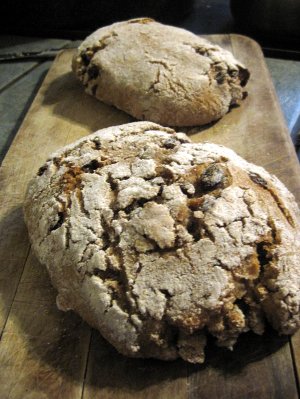
delicious homemade bread
Growing the food is only one part of the equation of feeding a community. Knowing how to preserve, prepare and craft masterful dishes is an on going life-skill.
For many people who come to Windward, the process of learning how to cook with whole, fresh food is a new endeavour. There is great subtlety in planing meals that are in alignment with the seasons, are economical, well rounded, and satisfy with the palette of the community.
Whether it is grinding local wheat and crafting a loaf of artisan bread, or milking the goats and making fresh goat cheese, there is a lot to do and learn in the culinary arts at Windward.
Find articles about cooking at Windward
Fermentation and Brewing

Fermentation (the transformation and preservation of food using bateria and molds) is an important and increasingly popular homestead craft. People have been fermenting things for a very long time. If it has a saccharide in it, you can ferment it!
The benefits of fermentation are many. Beyond the helth benefits of eating living food, we understand fermentation to be a low-tech, low-energy way to preserve the seasonal abundance.
The subtlety and art of fermenting is a field of knowledge all it’s own, and something which we recognize as a valuable part of any community’s long term food security and health.
There are lots of fermentation projects that we have done, or continue to do here at Windward. Sauerkraut, sour-dough, kombucha, kefir, yogurt, Aged cheeses, vinegar, mead, country wines, beer and cider.
Find article about fermentation and brewing at Windward.
Music, Body Work and Storytelling
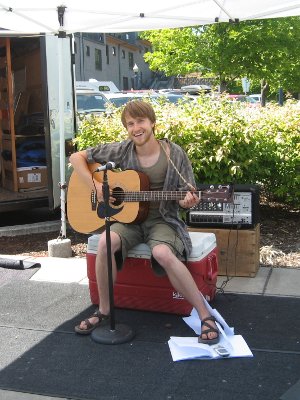
Sam, 2010 Intern, playing his songs at a local farmer’s market
Nalla Walla of the Bcollective said it pretty well,
Technologies of the social realm like dance, ritual, storytelling, and song (the original software!) have always served as communication methods, social exchange and conflict resolution strategies, information transmission schema, knowledge banks, and efficient energy utilization patterns. And, as anyone involved in ecological and activist groups can attest, it is primarily social conflict that impedes our progress and creates burnout, not lack of hard-tech. The Arts have always served as grease for the social wheels. Thus, if social dysfunction is the great limiting factor in implementing truly ecological habitats, it is greatly helpful to view them as tools for re-indigenization.
Most of us here play music in some form or another, and we periodically have group nights with live music. Being in community, there are lots of stories to tell, many of which have important lessons behind them. Music, song and story are all slowly being interwoven into the culture of Windward. It is perhaps one of the most obvious examples of how a culture is inevitably created when people start living closely with one another. It is very cool to be a part of!
Dance, movement and body work are valuable healing, therapeutic, and integrative parts of life. While we are not generally a group who goes dancing around everywhere, we all have excercise and yogic elements that are highly integrated into our life. These practices help us to check in with our body and mind, so that we are prepared to engage in the working life of building and sustaining a village without hurting ourselves, or being stricken with boredom and impatience.
We are interested in finding more and better ways to integrate music, storytelling, dance and other types of rhythmic arts into our life. If you are someone who has these skills, we want you to know they are much appreciated and welcome! Despite the more serious face that may come across via the website.
Find articles about music, dance and storytelling at Windward.
